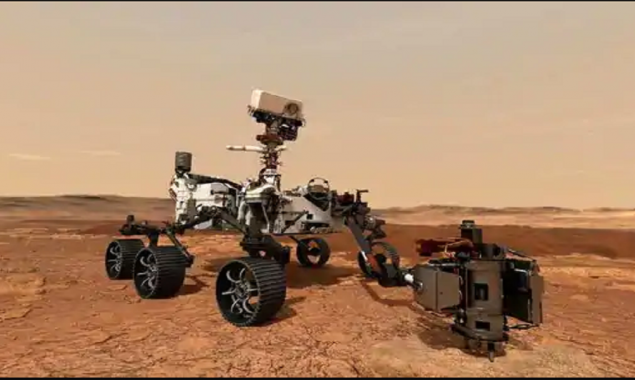Nasa’s Perseverance rover in ‘great shape’ after Mars landing
NASA has successfully landed its Perseverance rover on the surface of Mars....

Nasa Perseverance rover Mars
This week, the Perseverance Mars rover from the American space agency will start releasing rock samples onto the surface of the Red Planet.
Small titanium tubes have been used to encapsulate the materials in the hope that they would be picked up by a future expedition and returned to Earth.
It marks a significant turning point in the investigation into the possibility of life on Mars.
It is believed that the problem can only be answered by examining rock and soil samples in Earth laboratories.
Ten cylinders will be positioned on the ground at Perseverance’s exploration site in Jezero Crater.
They are composed of a mixture of volcanic and sedimentary rocks that have been drilled by the robot over the previous 15 months.
Additionally, there will be instances of Martian air and soil.
On Tuesday or Wednesday, the first tube around the size of a finger should be in place.
The drop will take place on a level area of land known as “Three Forks.”
NASA’s top Mars scientist, Mike Meyer, said, “The surface is like a pool table – incredibly uninteresting.”
Future missions will find it simpler to land and recover the store as a result of this.
To be clear, the collection that will be accumulated over the coming weeks is more of a “Plan B” than the main return cache.
Perseverance will keep copies of the samples in the hopes that it can give them, along with other samples that are still being drilled, directly to the mission that arrives to carry them home. However, Nasa cannot take a chance on the rover breaking down with all the rocks still inside of it.
Because of this, the Three Forks depot is essential, according to mission scientist Meenakshi Wadhwa of Arizona State University, “because it ensures that a scientifically valuable sample collection will be accessible for Earth return in case Perseverance is unable to deliver for whatever reason.”
It strengthens the plans for our Mars sample return, she informed the press.
The fetch mission will be sent directly to Three Forks if Perseverance dies in the nightmare scenario.
It will feature two claw-equipped drones that can grasp the tubes and transport them to the rocket system, where they will be launched off Mars for the trip back to Earth.
The depot samples, according to scientists, provide a wide range of analysis opportunities.
They will learn more about Jezero Crater’s age and the overall geological history of Mars from the volcanic materials.
The sedimentary rocks will be the ones that are most interested in looking for signs of ancient biology.
These were persistently dug from Jezero’s remaining delta reserves.
A delta is a structure formed by the silt and sand that rivers deposit as they slow down as they enter larger bodies of water.
The type of feature it is could possibly have trapp
The question of life could only be answered using the advanced methods available on Earth, according to Lori Glaze, head of planetary science at NASA.
“With our remote-sensing tools, we can do a lot on-site, but we are unable to travel to Mars’ surface with all of our laboratory tools and human knowledge. Thus, we bring the samples back here where we can use all of our cutting-edge equipment, store them for decades, and come up with novel testing methods for the samples that we haven’t even considered yet “She revealed in an interview.
The store will be built in a little more than a month. The tubes will be arranged in a zigzag configuration, around 6m away from one another. After that, pictures and a catalogue of their precise locations will be created.
Perseverance and its scout chopper, Ingenuity, will climb up onto the top of the delta once this operation is over in order to begin the next stage of their mission.
More than 20 unused sample tubes are still present aboard the rover and are waiting to be filled with additional fascinating rocks.
Midway through 2028, a sample-retrieval mission with a two-year cruise duration that includes a landing platform, helicopters, a robotic arm, and a return rocket is likely to depart Earth for Mars.
It would return to Earth in 2033 with the sample tubes it purchases, whether from the Three Forks store or directly from Perseverance somewhere else.
The European Space Agency and the project are partners. At last week’s American Geophysical Union Fall Meeting, the plan was discussed.
Catch all the Sci-Tech News, Breaking News Event and Latest News Updates on The BOL News
Download The BOL News App to get the Daily News Update & Follow us on Google News.